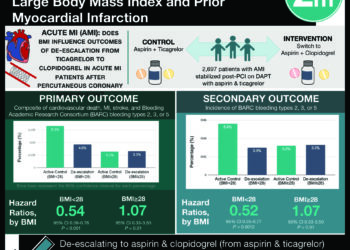BMI, waist circumference associated with semen quality
Image: PD
1. Waist circumference was inversely associated with both semen volume and sperm count.
2. Obese men were 19 times more likely to have low total sperm counts and 15 times more likely to have low semen volumes.
Evidence Rating Level: 2 (Good)
Study Rundown: This study found that increasing BMI and waist circumferences were associated with lower semen volumes and sperm counts. This is one of the first studies to assess the effects of exercise and waist circumference in addition to BMI on semen parameters. Researchers enrolled participants prior to conception, making results more broadly generalizable than those from an infertile cohort. Limitations include a relatively homogeneous population (mostly white, educated, overweight men with little physical exercise). Future studies might employ a heterogeneous population and assess semen parameters in addition to time to conception, a more useful outcome.
Click to read the study in Human Reproduction
Relevant Reading: BMI in relation to sperm count: an updated systematic review and collaborative meta-analysis
Study Author, Dr. Michael L. Eisenberg, MD, talks to 2 Minute Medicine: Departments of Urology, Obstetrics and Gynecology, Stanford University School of Medicine
“Obesity, as assessed by both body mass index (BMI) and waist circumference, increases a man’s risk of impaired sperm quality. In addition to the health impacts of obesity, students should also recognize the reproductive effects. Future research is necessary to determine if weight loss can reverse these impacts.”
In-Depth [prospective cohort]: Researchers collected semen samples from 468 men (93% participation) in the Longitudinal Investigation of Fertility and the Environment (LIFE) Study, a population-based prospective cohort of couples attempting conception. Men were categorized by BMI and semen samples were analyzed by volume, sperm count, concentration, motility, morphology, and vitality. Regressions were adjusted for covariates including age, college education, and smoking status.
Compared with men with a normal BMI, obese men were more likely to have low sperm count (OR=19.55, 95% CI 2.2-177.3) and semen volume (OR=15.15, CI 1.43-160.19). BMI was inversely associated with semen volume (p-trend 0.005), while waist circumference was inversely associated with both semen volume (p-trend 0.003) and sperm count (p-trend 0.004). Exercise was not significantly associated with change in semen parameters.
By Maren Shapiro and Leah Hawkins, MD, MPH
More from this author: IUD contraception equally safe in teenagers as in older women, Black men less likely to receive follow-up for elevated prostate cancer marker, PSA, Intake of fish fatty acids associated with lower risk of breast cancer, USPSTF recommends chemoprevention for women at high risk for breast cancer, Insurance status affects treatment of early stage breast cancer, SERMs decrease breast cancer risk even after treatment
©2012-2013 2minutemedicine.com. All rights reserved. No works may be reproduced without expressed written consent from 2minutemedicine.com. Disclaimer: We present factual information directly from peer reviewed medical journals. No post should be construed as medical advice and is not intended as such by the authors, editors, staff or by 2minutemedicine.com. PLEASE SEE A HEALTHCARE PROVIDER IN YOUR AREA IF YOU SEEK MEDICAL ADVICE OF ANY SORT.






